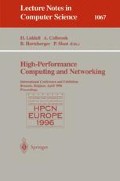Abstract
This article provides some insight in the runtime behavior of asynchronous methods for parallel molecular dynamics simulations that we recently introduced. From this, the advantages of the asynchronous mode of operation becomes very obvious, i.e. the abilities to hide message passing latencies, to reduce network congestion and to level out processing power and/or load fluctuations. The conclusions are validated by simulation runs on a network of up to 12 workstations, comparing the results to a synchronous mode of execution.
Preview
Unable to display preview. Download preview PDF.
References
Allen, M. P.; Tildesley, D. J.: Computer Simulation of Liquids. Oxford University Press, 1987.
Bertsekas, D. P.; Tsitsiklis, J. N.: Parallel and Distributed Computation: Numerical Methods. Prentice Hall, 1989.
Butenuth, R.: Message Passing in Parallel Operating Systems and Applications. Proc. High Performance Computing '96, New Orleans.
Dormanns, ML; Sprangers, W.: On the Precision of Asynchronous Parallel Molecular Dynamics Simulations. Technical Report, Chair for Operating Systems, RWTH Aachen, Oct. 1995.
Dormanns, M. Sprangers, W.; Bemmerl, T.: Feasibility of Asynchronous Parallel Molecular Dynamics Simulations. Proc. High Performance Computing '96, New Orleans.
Elliot, W. D.: Revisiting the Fast Multipole Algorithm Error Bounds. Technical Report 94-008, Duke University, Dept. of Electrical Engineering, Durham, NC, Jan. 1995.
Gropp, W.; Lusk, E.;Skjellum, A.: Using MPI: Portable Parallel Programming with the Message-Passing Interface. MIT Press, 1994.
Günther, H.; Bemmerl, T.: Programming Scalable HPC Systems: Tools and their Application. Speedup Journal, Vol. 9, No. 1, pp. 68–71, 1995.
Plimpton, S.: Fast Parallel Algorithms for Short-Range Molecular dynamics. J. of Comp. Phy., Vol. 117, pp. 1–19, March 1995.
Street, W. B.; Tildesley, D. J.; Saville, G.: Multiple time step methods in molecular dynamics. Mol. Phys., Vol. 35, No. 3, pp. 639–648, 1978.
Strumpen, V.; Casavant, T. T.: Implementing Communication Latency Hiding in High-Latency Computer Networks. Proc. HPCN '95, Springer LNCS, pp. 86–93, 1995.
Author information
Authors and Affiliations
Editor information
Rights and permissions
Copyright information
© 1996 Springer-Verlag Berlin Heidelberg
About this paper
Cite this paper
Dormanns, M., Sprangers, W. (1996). Experiences with asynchronous parallel molecular dynamics simulations. In: Liddell, H., Colbrook, A., Hertzberger, B., Sloot, P. (eds) High-Performance Computing and Networking. HPCN-Europe 1996. Lecture Notes in Computer Science, vol 1067. Springer, Berlin, Heidelberg. https://doi.org/10.1007/3-540-61142-8_550
Download citation
DOI: https://doi.org/10.1007/3-540-61142-8_550
Published:
Publisher Name: Springer, Berlin, Heidelberg
Print ISBN: 978-3-540-61142-4
Online ISBN: 978-3-540-49955-8
eBook Packages: Springer Book Archive

